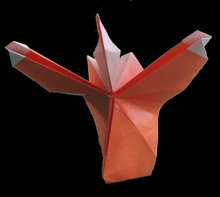
Since traditional Origami works over a perfectly squared piece of paper, the issue of obtaining it has become one of the greatest importance. How many of us has coursed to the heavens when we realize that our "special for origami" sheet is nor even a rectangle but a totally irregullar quadrilateral figure?
Through the years I've used diferent methods to "square" this sheets, with varied results; for example if the sheet is a regullar rectangle you can fold the bisector of one of the corners, this is one of the main diagonals, the intersection of it with the opposite side will determine the other corner of the square.

There is also the case of a long sheet came from a roll of paper, where you know that two opposite sides are perfectly parallel, then it's only necessary to fold a median perpendicular to both edges alining them, and then cutting both layers in a distance equals to half the height of the sheet, as is showed below; of course you will need a good graduated rule for this.

However, these methods fail when our sheet is an irregullar quadrilateral, like the fellow in the heading of this post.
To find a safe way to rescue the hidden square of our paper I went back to the teachings of my old Math's school professor (Carlos "the lizard" Zuñiga): "to construct a geometrical figure go back to the characteristic that defines it, the one that give it the being..." in this case, the 90° angles of its corners. The idea then is to inscribe a rectangular angle on one of their corners with a set square (or the corner of a copy machine sheet of paper)

we cut this angle. Over it you can fold the main diagonal, aligning one side on the other, this diagonal will be our future simmetry axis.

Then, to construct the second diagonal, we reflects the rectangular angle on the opposite side by folding in the closer adyacent corner and aligning the simmetry axis over itself, obtaining in that way a perfectly inscribed square to be cutted.

Finally to remark that if you use one of the side to inscribe the first rectangular angle you save one of the cuttings.
I hope it works for you all ;) many regards
Through the years I've used diferent methods to "square" this sheets, with varied results; for example if the sheet is a regullar rectangle you can fold the bisector of one of the corners, this is one of the main diagonals, the intersection of it with the opposite side will determine the other corner of the square.

There is also the case of a long sheet came from a roll of paper, where you know that two opposite sides are perfectly parallel, then it's only necessary to fold a median perpendicular to both edges alining them, and then cutting both layers in a distance equals to half the height of the sheet, as is showed below; of course you will need a good graduated rule for this.

However, these methods fail when our sheet is an irregullar quadrilateral, like the fellow in the heading of this post.
To find a safe way to rescue the hidden square of our paper I went back to the teachings of my old Math's school professor (Carlos "the lizard" Zuñiga): "to construct a geometrical figure go back to the characteristic that defines it, the one that give it the being..." in this case, the 90° angles of its corners. The idea then is to inscribe a rectangular angle on one of their corners with a set square (or the corner of a copy machine sheet of paper)

we cut this angle. Over it you can fold the main diagonal, aligning one side on the other, this diagonal will be our future simmetry axis.

Then, to construct the second diagonal, we reflects the rectangular angle on the opposite side by folding in the closer adyacent corner and aligning the simmetry axis over itself, obtaining in that way a perfectly inscribed square to be cutted.

Finally to remark that if you use one of the side to inscribe the first rectangular angle you save one of the cuttings.
I hope it works for you all ;) many regards




No comments:
Post a Comment